Ara is a small constellation located in the southern sky. Its name means “the altar” in Latin. The constellation represents the altar used by Zeus and other Greek gods to swear a vow of allegiance before they went to war against Cronus and the Titans. In another Greek myth, Ara represents the altar of King Lycaon of Arcadia.
Ara was one of the 48 Greek constellations listed by the astronomer Claudius Ptolemy in the 2nd century. It is located just south of Scorpius, under the scorpion’s tail.
The constellation contains several notable deep sky objects: the Stingray Nebula, the open clusters Westerlund 1 (Ara Cluster) and NGC 6193, the globular clusters NGC 6397, NGC 6352 and NGC 6362, the barred spiral galaxy NGC 6300, the planetary nebula NGC 6326 and the pre-planetary Water Lily Nebula.
Facts, location and map
Ara is one of the smaller constellations (63rd in size), with an area of 237 square degrees. It lies in the third quadrant of the southern hemisphere (SQ3) and can be seen at latitudes between +25° and -90°.
The neighboring constellations are Apus, Corona Australis, Norma, Pavo, Scorpius, Telescopium, and Triangulum Australe.
The constellation name Ara is pronounced /ˈɛərə/. In English, the constellation is known as the Altar. The genitive form of Ara, used in star names, is Arae (pronunciation: /ˈɛəriː/). The three-letter abbreviation, adopted by the International Astronomical Union (IAU) in 1922, is Ara.
Ara has seven stars with known exoplanets: Mu Arae (four planets), Gliese 676 (binary system with four planets), HD 154857 (one confirmed and one suspected planet), Gliese 674, HD 152079, HD 154672 and HD 156411
Ara contains two stars brighter than magnitude 3.00 and three stars located within 10 parsecs (32.6 light years) of Earth. The brightest star in the constellation is Beta Arae. The nearest star, Gliese 674 (spectral class M3V), lies at a distance of 14.80 light years from Earth. There are no meteor showers linked to Ara. The constellation does not contain any Messier objects.
Ara contains two named stars. The names of stars that have been officially approved by the International Astronomical Union (IAU) are Cervantes and Inquill.
Ara belongs to the Hercules family of constellations, together with Aquila, Centaurus, Corona Australis, Corvus, Crater, Crux, Cygnus, Hercules, Hydra, Lupus, Lyra, Ophiuchus, Sagitta, Scutum, Serpens, Sextans, Triangulum Australe, and Vulpecula.
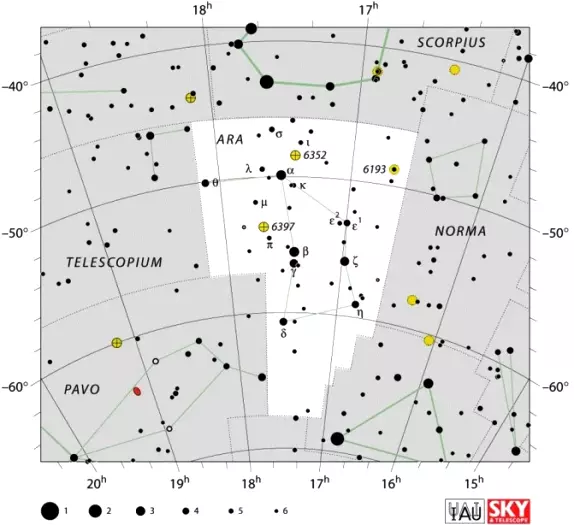
Ara constellation map by IAU and Sky&Telescope magazine
Myth
There are several myths associated with the constellation. In one of them, Ara represents the altar on which Zeus and other gods vowed to defeat the Titans and overthrow Cronus, who ruled the universe. Cronus was one of the 12 Titans who had deposed his father Uranus, the previous ruler.
When a prophecy said that the same fate would befall Cronus and he would be defeated by one of his own children, to prevent it from happening, he swallowed all his children – Hestia, Demeter, Hera, Hades, and Poseidon – all of them future gods and goddesses. When the youngest child, Zeus, was born, his mother Rhea hid him in Crete and gave Cronus a stone to swallow, telling him the stone was Zeus.
When Zeus grew up, he made Cronus vomit his brothers and sisters. Once freed, they swore to overthrow Cronus and the Titans. The war between the gods and the Titans lasted a decade and the gods won in the end. Zeus became the god of the sky, Poseidon became the god of the sea, and Hades the ruler of the underworld. Zeus placed the altar among the stars to commemorate the gods’ victory.
In another story, Ara represents the altar of Lycaon, the king of Arcadia who decided to test Zeus by serving him a meal of a dismembered child, and later tried to do away with the god while he slept. Zeus, enraged, transformed Lycaon into a wolf and struck down his 50 sons with lightning bolts. In one version of the tale, the sacrificed child was Arcas, the son of Zeus and Lycaon’s daughter Callisto.
Major stars in Ara
β Arae (Beta Arae)
Beta Arae is an orange K-type bright giant (possibly supergiant), approximately 603 light years distant. With an apparent magnitude of 2.84, it is the brightest star in the Ara constellation.
α Arae (Alpha Arae)
Alpha Arae, the second brightest star in Ara, is a variable Be star, a B-type star with prominent emission lines of hydrogen in its spectrum. Its apparent magnitude varies between 2.76 and 2.90.
Alpha Arae is approximately 240 light years from Earth.
It rotates very quickly (estimated speed at the equator is 470 km/s) and, as a result of this, the star is surrounded by an equatorial disk of ejected material.
γ Arae (Gamma Arae)
Gamma Arae is a blue-white B-type supergiant, approximately 1140 light years distant. It has a visual companion 17.9 arc seconds away. The companion is a white A-type main sequence dwarf. Gamma Arae has an apparent magnitude of 3.5.
ζ Arae (Zeta Arae)
Zeta Arae is another orange K-type giant, about 574 light years distant. It has an apparent magnitude of 3.12.
μ Arae (Mu Arae)
Mu Arae (HD 160691) is a main sequence G-type star that has four known planets in its orbit. It is approximately 50 light years distant and has an apparent magnitude of 5.12. Three of the four planets in the star’s orbit have masses similar to that of Jupiter.
ε Arae (Epsilon Arae)
Epsilon Arae is a binary star system. Epsilon-1 Arae has an apparent magnitude of 4.06 and is about 300 light years distant. It is an orange K-type giant.
Epsilon-2 Arae is a binary star, 85.9 light years away, with an apparent magnitude of 5.27. The primary component is a yellow-white F-type main sequence dwarf. The closer companion star is only 0.6 arc seconds away and has an apparent magnitude of 8.6. The system has a third component, a 13th magnitude star found 25 arc seconds away from the primary star.
Deep sky objects in Ara
NGC 6193
NGC 6193 is a large open cluster that contains 27 stars, many of them binaries. The cluster lies eight degrees west and one degree north of Alpha Arae. Its estimated age is 3 million years.
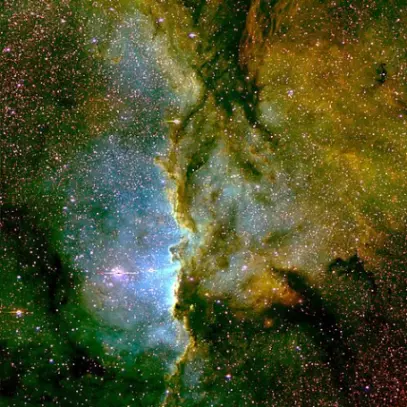
NGC 6193. Photo by Rbarba. Three-colors image of NGC 6193 and NGC 6188 obtained with the Curtis-Schmidt telescope at Cerro Tololo Inter-American Observatory (Chile).
The two hottest stars in the cluster are responsible for the illumination of NGC 6188, an emission nebula also located in Ara constellation.
NGC 6193 has a visual magnitude of 5.2, is 15′ in diameter, and lies approximately 4,300 light years from Earth.
NGC 6397
NGC 6379 is a bright globular star cluster located three degrees to the northeast of Beta Arae. It contains about 400,000 stars. The cluster is approximately 7,200 light years distant, which makes it one of the nearest globular clusters to us. It was first discovered in the mid-18th century by the French astronomer Nicolas Lacaille.
The cluster is notable for the number of blue stragglers it contains. (Blue stragglers are main sequence stars that are bluer, two to three times more massive, and a few magnitudes above the stars at the main sequence turn-off point for the cluster.)
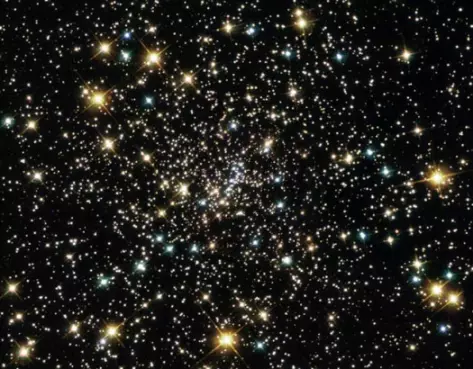
NGC 6397, photo: NASA/ESA and the Hubble Heritage Team (AURA/STScI)
Stingray Nebula (Hen 3-1357)
The Stingray Nebula is a planetary nebula approximately 18,000 light years from Earth. It is the youngest planetary nebula known. The central star is a white dwarf that has a companion 0.3 arc seconds away. The nebula has an apparent magnitude of 10.75.
Even though it is significantly smaller than most other planetary nebulae discovered so far, the Stingray Nebula is 130 times larger than our solar system.
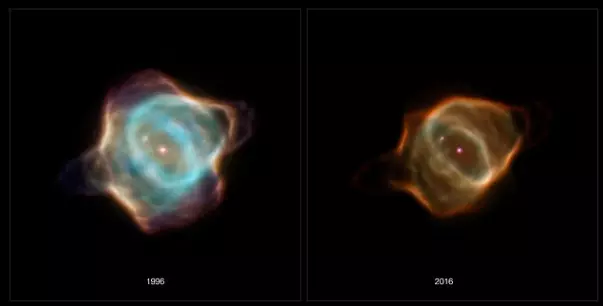
Archival data from the NASA/ESA Hubble Space Telescope reveal that the nebula Hen 3-1357, nicknamed the Stingray nebula, has faded precipitously over just the past two decades. Witnessing such a swift rate of change in a planetary nebula is exceedingly rare, say researchers. These images captured by Hubble in 1996 (left), when compared to Hubble images taken in 2016 (right), show a nebula that has drastically dimmed in brightness and changed shape. Bright blue shells of gas near the centre of the nebula have all but disappeared, and the wavy edges that earned this nebula its aquatic-themed name are virtually gone. The young nebula no longer pops against the black velvet background of the distant Universe. Image: NASA, ESA, B. Balick (University of Washington), M. Guerrero (Instituto de Astrofísica de Andalucía), and G. Ramos-Larios (Universidad de Guadalajara)
NGC 6362
The globular cluster NGC 6362 has an apparent magnitude of 8.3 and lies at a distance of about 24,800 light years from Earth. It is located near the border with the constellation Apus.
NGC 6362 was discovered by the British astronomer James Dunlop on June 30, 1826.
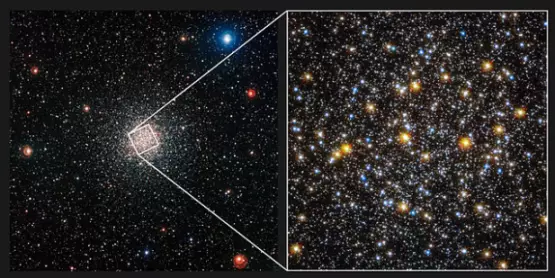
This colourful view of the globular cluster NGC 6362 on the left was captured by the Wide Field Imager attached to the MPG/ESO 2.2-metre telescope at ESO’s La Silla Observatory in Chile. This brilliant ball of ancient stars lies in the southern constellation of Ara (The Altar). The close up view of the core of the cluster on the right is from the NASA/ESA Hubble Space Telescope. Image: ESO
The cluster is estimated to be 13.57 billion years old and composed mostly of evolved red giant stars. It also contains a number of blue stragglers, stars that appear younger than they really are. These stars are bluer and more luminous than their neighbours either because they were formed in collisions of two old stars or because they have stolen mass from their companions.
NGC 6326
NGC 6326 is an irregular planetary nebula in Ara. It has a visual magnitude of 12.2 and lies at an approximate distance of 11,000 light years from Earth. The nebula was discovered by the Scottish astronomer James Dunlop on August 26, 1826. It occupies an area 0.32′ in size.
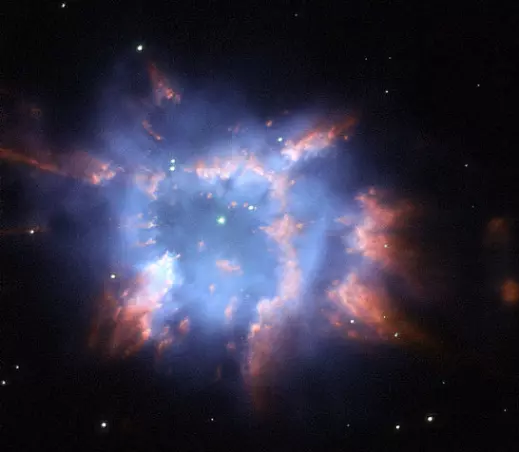
The Hubble Space Telescope captured this beautiful image of NGC 6326, a planetary nebula with glowing wisps of outpouring gas that are lit up by a central star nearing the end of its life. When a star ages and the red giant phase of its life comes to an end, it starts to eject layers of gas from its surface leaving behind a hot and compact white dwarf. Sometimes this ejection results in elegantly symmetric patterns of glowing gas, but NGC 6326 is much less structured. This object is located in the constellation of Ara, the Altar, about 11 000 light-years from Earth. This picture was created from images taken using the Hubble Space Telescope’s Wide Field Planetary Camera 2. The red light was captured through a filter letting through the glow from hydrogen gas (F658N). The blue glow comes from ionised oxygen and was recorded through a green filter (F502N). The green layer of the image, which shows the stars well, was taken through a broader yellow filter (F555W). The total exposure times were 1400 s, 360 s and 260 s respectively. The field of view is about 30 arcseconds across. Image: ESA/Hubble and NASA
NGC 6300
NGC 6300 is a barred spiral galaxy classified as a Seyfert galaxy. It has a visual magnitude of 8.78 and lies at a distance of 50.9 million light years from Earth. The galaxy was discovered by James Dunlop on June 30, 1826. It is suspected to contain a black hole with a mass 300,000 times that of the Sun.
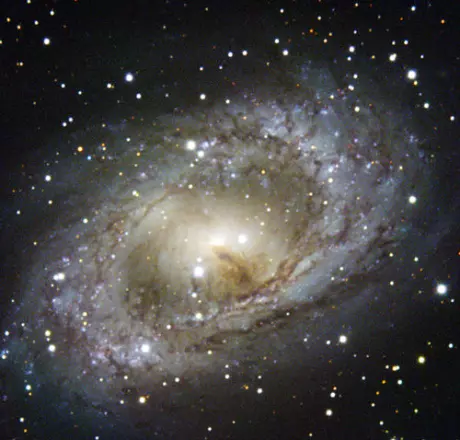
This image shows the bright centre and swirling arms of the spiral galaxy NGC 6300. NGC 6300 is located in a starry patch of sky in the southern constellation of Ara (The Altar) which contains a variety of intriguing deep-sky objects. NGC 6300 has beautiful pinwheeling arms connected by a straight bar that cuts through the middle of the galaxy. While it may look like a standard spiral galaxy in visible-light images like this one, it is actually a Seyfert II galaxy. Such galaxies have unusually luminous centres that emit very energetic radiation, meaning that they are often intensely bright in part of the spectrum either side of the visible. NGC 6300 is thought to contain a massive black hole at its heart some 300 000 times more massive than the Sun. This black hole is emitting high energy X-rays as it is fed by the material that is pulled into it. This image of NGC 6300 was taken by the ESO Faint Object Spectrograph and Camera (EFOSC2) on the 3.58-metre New Technology Telescope (NTT). Image: ESO/C. Snodgrass
NGC 6352
NGC 6352 is a globular cluster with an apparent magnitude of 7.8. It occupies an area 7.1′ in size and lies at a distance of 19,570 light years from Earth. Also known as Caldwell 93, the cluster is a relatively loose one. Individual stars can be resolved in 6-inch and larger telescopes.
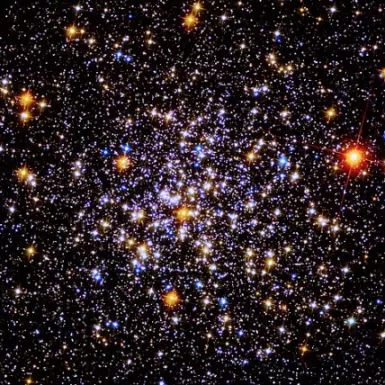
Caldwell 81, or NGC 6352, is a loose globular star cluster located roughly 20,000 light-years from Earth. This cluster is located in the constellation Ara and was discovered in 1826 by Scottish astronomer James Dunlop while he lived in Australia. With an apparent magnitude of 7.8, Caldwell 81 can be found with a small telescope. The cluster is best viewed in the Southern Hemisphere during winter but can also be observed from equatorial latitudes in the Northern Hemisphere during its summer. This image of Caldwell 81 is a composite of visible and infrared observations using Hubble’s Advanced Camera for Surveys and ultraviolet observations using its Wide Field Camera 3. These observations were made to help astronomers understand the characteristics of the cluster’s stars and investigate the evolution of globular clusters. The researchers were able to track the motion of the stars in the cluster and better determine Caldwell 81’s age, which is roughly 12 billion years. Image: NASA, ESA, A. Sarajedini (Florida Atlantic University), A. Kong (National Tsing Hua University), and G. Piotto (Università degli Studi di Padova); Processing: Gladys Kober (NASA/Catholic University of America)
Ara Cluster (Westerlund 1)
The Ara Cluster is a compact young open cluster located approximately 12,100 light years from Earth. It was named Westerlund 1 after Bengt Westerlund, the Swedish astronomer who discovered it in 1961.
Westerlund 1 is one of the most massive young clusters in our galaxy. It contains an unusually high number of rare high-mass stars, including the red supergiant Westerlund 1-26. Westerlund 1-26 is one of the largest stars known, with a radius approximately 1,530 times that of the Sun.
The Ara Cluster is also home to 6 yellow hypergiants, 3 other red supergiants, 24 Wolf-Rayet stars, a considerable number of OB supergiants, and a luminous blue variable.
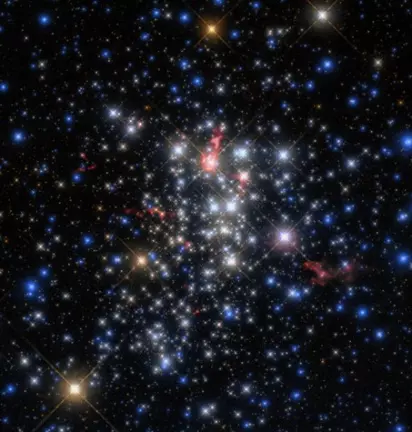
This spectacular Picture of the Week was produced from data gathered by the Atacama Large Millimeter/submillimeter Array (ALMA) in Chile, combined with data from the NASA/ESA Hubble Space Telescope. It shows a cluster of stars named Westerlund 1, one of the most massive young star clusters known to reside in the Milky Way. Excitingly, it also shows the comet-like “tails” of material stretching away from some of the giant stars in Westerlund 1. Such tails are formed in the thick, relentless winds that pour from the cluster’s stellar residents, carrying material outwards. This phenomenon is similar to how comets get their famous and beautiful tails. Comet tails in the Solar System are driven away from the nucleus of their parent comet by a wind of particles that streams out from the Sun. Consequently comet tails always point away from our Sun. Similarly, the tails of the huge red stars shown in this image point away from the core of the cluster, likely the result of powerful cluster winds generated by the hundreds of hot and massive stars found towards the centre of Westerlund 1. These massive structures cover large distances and indicate the dramatic effect the environment can have on how the stars form and evolve. These comet-like tails were detected during an ALMA study of Westerlund 1 that aimed to explore the cluster’s constituent stars and figure out how, and at what rate, they lose their mass. The cluster is known to host a large amount of massive stars, many of them intriguing and rare types, making it of great interest and use to astronomers wishing to understand the myriad stars in our galaxy. Image: ESO/D. Fenech et al.; ALMA (ESO/NAOJ/NRAO), December 2018
Water Lily Nebula
The Water Lily Nebula, catalogued as IRAS 16594-4656, is a pre-planetary nebula found in Ara. It is in the process of evolving into a planetary nebula. The nebula was discovered and imaged by the Hubble Space Telescope.
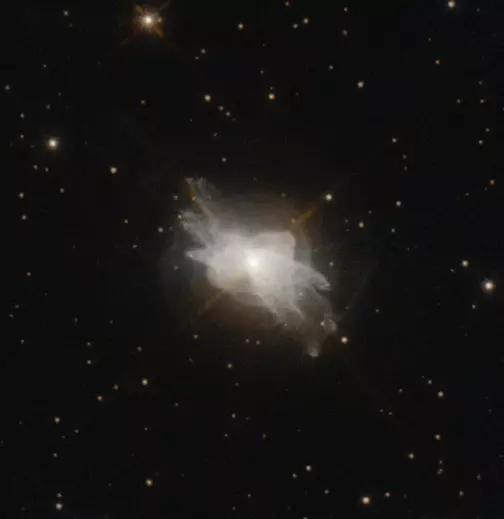
The Water Lily Nebula, image: Judy Schmidt (CC BY 2.0)
Other deep sky objects in Ara include the intermediate spiral galaxy NGC 6328, the barred spiral galaxy NGC 6221, the young open cluster NGC 6250, the spiral galaxies NGC 6215 and NGC 6221, the open clusters IC 4651, NGC 6200, NGC 6204, and NGC 6208, and the globular cluster ESO 280-SC06.